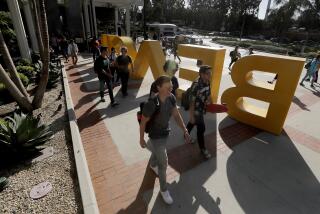CSU to Move on Plan for Campus : Taylor Ranch: The university will go ahead with an environmental impact report.
- Share via
Cal State University officials said they will move forward with plans to develop a four-year campus at Taylor Ranch despite a Ventura City Council resolution that withdraws the city’s endorsement of the site unless a new study shows that the 450-acre parcel on the city’s western outskirts is the best possible location.
“We don’t feel like we have to take that advice,” said CSU Vice Chancellor John Smart, referring to the city resolution. “Our focus is Taylor Ranch and that’s going to be the direction of our environmental impact report.”
University officials acknowledge that under state law, a CSU-sponsored environmental impact report--the final step in the plan-approval stage before construction of the campus can begin--must weigh alternative sites. But they add that they have already conducted two site selection studies and are committed to Taylor Ranch.
“We are the lead agency in this project and someone has to take responsibility,” Smart said.
On Monday, the council adopted a resolution saying the city “cannot endorse” Taylor Ranch “until a comprehensive environmental document evaluates the merits and impacts associated with Taylor Ranch in comparison to other viable alternative sites.”
The city’s previous position was one of unconditional support for Taylor Ranch, the site selected by Cal State. In December, 1987, then-Mayor James Monahan sent a short letter to the university expressing “the city’s formal endorsement of and support for the Taylor Ranch site.” The council also unanimously approved the Taylor Ranch site last summer as part of the city’s comprehensive growth plan for the year 2010.
The new resolution, while not opposing Taylor Ranch outright, asks that a two-phase environmental impact report be conducted. The report’s first phase would be devoted to selecting the best site available in western Ventura County.
If Taylor Ranch is not the preferred choice after the first phase is completed, the resolution states that “the newly preferred site should become the focus of the EIR, with the Taylor Ranch site being evaluated as an alternative.”
The resolution in effect asks for a site-selection study to precede the environmental report--a request at odds with Cal State’s position that Taylor Ranch has already been picked as the best site and that an environmental report should be conducted for that site.
But the city has virtual veto power on the project because the campus cannot be constructed unless Ventura agrees to annex Taylor Ranch and provide water and other services, an issue at the center of delicate ongoing negotiations between the university and the city.
A complicating factor in the negotiations is that the Ventura council remains deeply divided on whether the university should be built and, if so, under what conditions.
In November, in a wave of slow-growth sentiment, three environmental candidates were elected with strong support from groups opposed to the Taylor Ranch project.
As a result, only three members on the council still support Taylor Ranch--Mayor Richard Francis, Monahan and Councilman John McWherter. Of the remaining council members, Gary Tuttle and Cathy Bean are against the site, which they fear will add to the city’s water, traffic and air pollution problems.
Council members Todd Collart and Donald Villeneuve have expressed serious reservations about Taylor Ranch, but said they are willing to support it if the environmental report shows that it is the best possible location.
The new resolution reflects a compromise among the three positions. Authored by Collart and introduced March 8, it was sent back to the council’s university subcommittee at Francis’ request for “fine tuning”--and to allow for more negotiations between the city and the university.
Since then, Collart met with Smart and the resolution was toned down from what university officials and pro-Taylor Ranch council members considered excessively confrontational language.
The original version stated that the city “should not be expected” to pay any of the costs of building or servicing the university if it is at Taylor Ranch. A sentence was added to the present version saying the city “may choose to join” university trustees in “projects it considers of mutual benefit.”
The original version demanded that the city have “permit approval and conditioning authority over development,” whereas the present version simply asks the university to provide “appropriate city notice and review for all project-related plans.”
Smart said he was satisfied with the latest version. “The spirit is a positive one,” he said. “And we are certainly willing to work out an accord with the city.”
More to Read
Sign up for Essential California
The most important California stories and recommendations in your inbox every morning.
You may occasionally receive promotional content from the Los Angeles Times.













